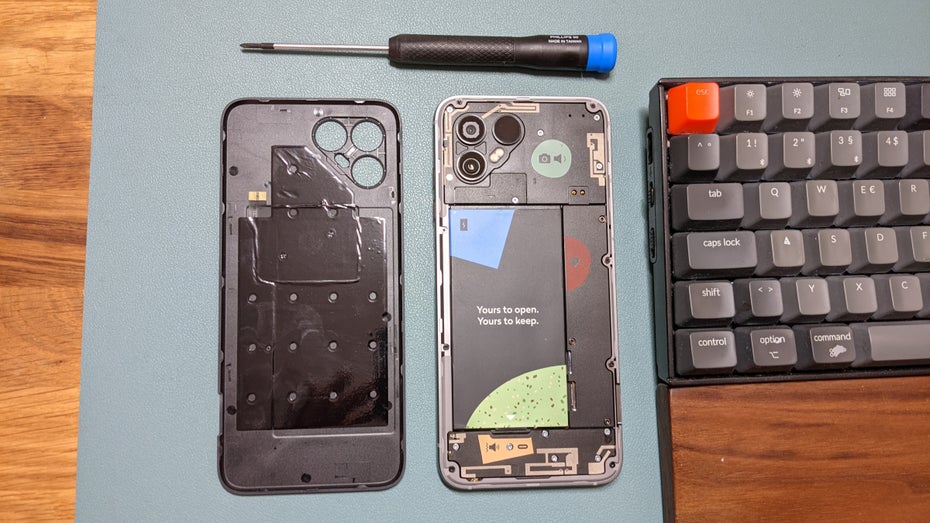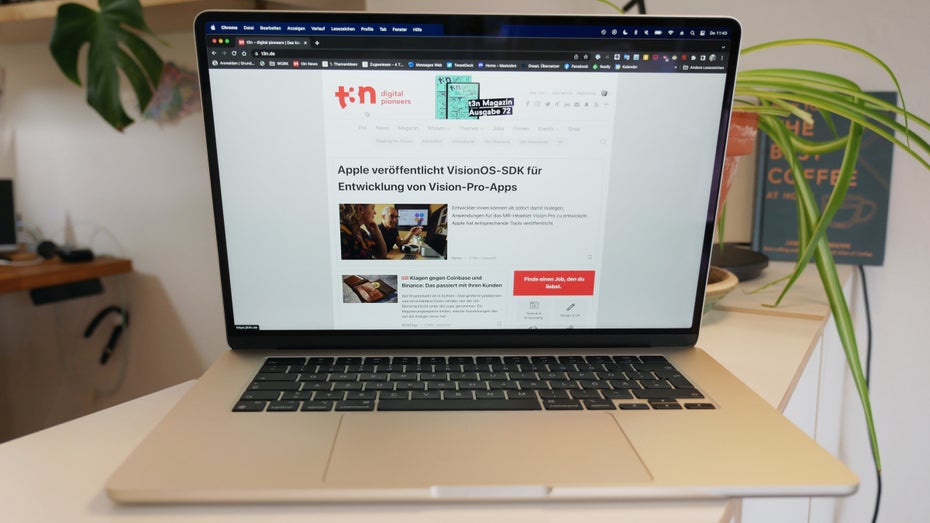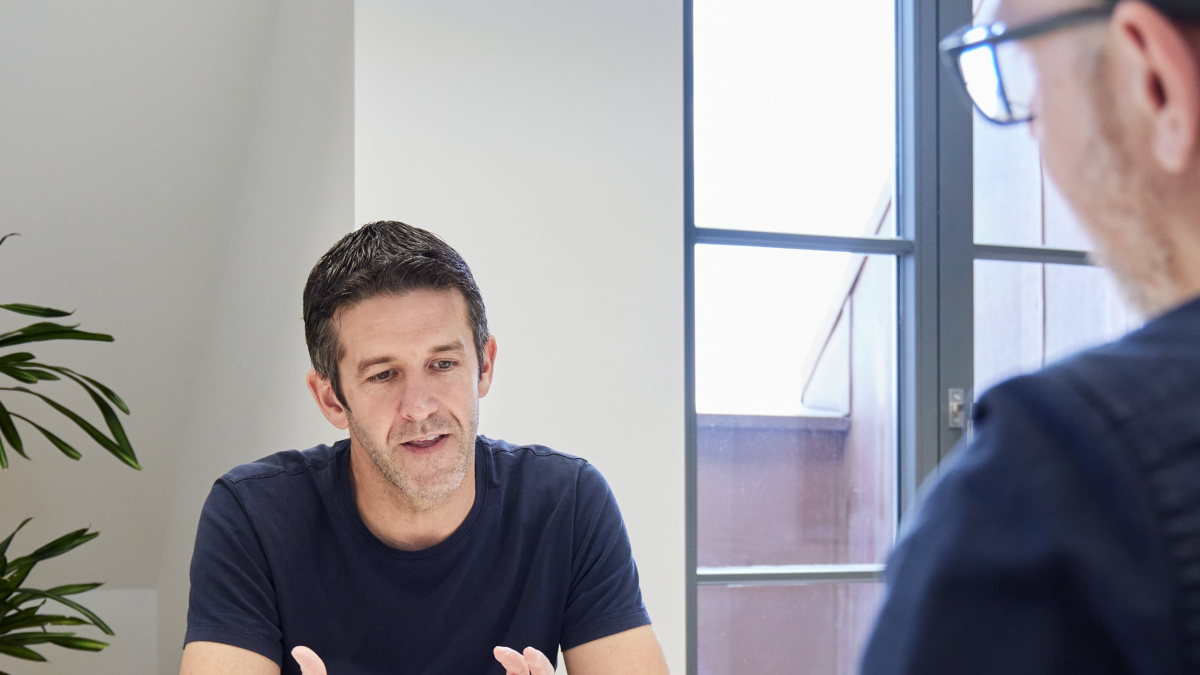Will the iPhone be CO₂ neutral? That says Apple’s hardware boss
Our interlocutor John Ternus In his role as head of hardware, he is responsible for the further development of Apple’s product range. According to him, his team aims for every new product to have a smaller CO₂ footprint than its predecessor.
“We’re just marching further down (towards CO₂ neutrality – editor’s note). In doing so, we are not willing to give up what makes an Apple product great,” says Ternus. When developing more sustainable products, Apple does not want to “compromise on safety, quality, reliability and the Apple experience,” adds the manager, who has worked at Apple since 2001.
His projects included all iPad models, Airpods and the iPhone 12 range. According to Apple, he was also instrumental in converting the Mac to its own chips.
Contents
- 1 Ternus: iPhones are built to last
- 2 Less glue – but you can’t do without it
- 3 Will iPhones become more like a Fairphone in the future?
- 4 Efficiency and new alloys as further building blocks for more sustainability
- 5 According to Ternus, Macbooks with Apple Silicon are more durable
- 6 Recycled aluminum and new alloys
Ternus: iPhones are built to last
Apple also follows this mantra in iPhone development, which Ternus underscores by stating that after three years, iPhones are worth on average 80 percent more than a comparable Android device. “They keep their value because they’re built so well,” he adds.
For Ternus, the way iPhones are built plays a crucial role. Among other things, Apple is investing in materials such as the “Ceramic Shield”, which protects the screen and, according to Ternus, is the strongest screen protection for smartphones. In addition, Apple “spent a lot of time” to achieve IP68 water resistance for iPhones and the Apple Watch.
“Our goal is to build a product that lasts.”
Ternus emphasizes that Apple’s goal is to build a product that lasts. If something should be defective, Apple will see that there are repair options – the company has now introduced a self-repair program for this purpose, which will also make it to Germany in 2022.
The iPhone 14 is a “butterfly” that can be opened from the front and back. (Photo: iFixit)
In terms of easier repairability, Apple has also introduced a new design with the iPhone 14 and 14 Plus. “We went from the so-called bucket architecture to this mid-chassis architecture,” explains Ternus. “This has greatly reduced the cost and complexity of repairing the rear glass,” said the manager.
Editor’s Recommendations
Incidentally, the repair experts at iFixit also see it that way. It is the most repairable iPhone since the iPhone 7. For the first time, the iPhone has a middle frame, which means that it can be opened from both the front and the back. This makes it easier, among other things, to replace the screen and the glass back.
So far, iFixit has criticized the construction of iPhones as difficult to repair.
According to Ternus, Apple has even reduced the use of adhesives. Instead of being able to pluck the batteries out of the glued housing completely and only with great effort, Apple now uses adhesive strips that can be easily removed using a tab.
“The best repair is the one you never have to do.”
However, Apple does not want to completely do without adhesive, as these adhesive strips fix the battery well and keep it in the right position, according to Ternus. This significantly reduces the “probability of reliability problems”.
When asked whether it would be conceivable to build iPhones even more modularly and thus make them as easy to repair as a Fairphone, Ternus declined. “The goal is to make a smartphone that lasts a long time. And I think when you look at a design that’s modular, there are a few challenges or downsides that come with that,” explains the manager.

Like a Fairphone, iPhones will never be able to be taken apart – according to John Ternus, there are reasons for this. (Photo: t3n)
He goes on to say that the connections between the individual components are often the source of errors. “So if you have more connections, you probably have more points of failure and the device becomes more prone to failure,” Apple’s hardware chief said.
Another point is that the connections used more material, so from a carbon footprint point of view you are actually going in the wrong direction. All of these design decisions involve trade-offs and compromises.
“I believe the path we’ve taken and the balance we have in terms of durability and repairability is the right path,” says Ternus.
Apart from the longevity and repairability of iPhones, Apple is pursuing the issue of sustainability in many other product areas. According to Ternus, the in-house processors also play a relevant role in this area. Beginning with the iPhone and the chips of the A series, Apple now uses self-developed ARM-based processors in all products.
Most recently, the company switched Macs and Macbooks to its own Apple silicon chips, making itself independent of Intel. According to Ternus, a major benefit of its own processors is the ability to make them better and more powerful by increasing efficiency and further boosting performance per watt.
The advantage of the new chips is the battery life, which allows a Macbook Pro to run for up to 22 hours. At the same time, the lifespan of the product can be extended, which, according to Ternus, consumes only a fraction of the energy of the previous (Intel – editor’s note) system.
With this development, Apple kills two birds with one stone: build something that is better for the environment and also better for the customer. The journey doesn’t end with the M2 chip either, Ternus hints.
Incidentally, a large part of the chip development takes place in Apple’s Munich development center. According to Ternus, around 2,000 employees work there, pushing the development of their own chips. Other locations are in Israel and the USA.
In addition to the higher energy efficiency, Macbooks with their own chips should also be more durable. Because in contrast to the previous models with Intel processors, Apple relies on a uniform memory from a single package with the chip. This approach contributes to “incredible performance, incredible efficiency and incredible reliability,” according to Ternus.

One of the current models with an M2 chip is the Macbook Air 15. (Photo: t3n)
The disadvantage of this structure is that the memory cannot be retrofitted later. When buying, you have to be sure that the SSD memory and RAM of the selected model are sufficient. On the other hand, repairability is considered less easy, since the SoC, memory and RAM form a unit.
However, Ternus is certain that this structure means that the probability of a repair is very, very low. “We think this is the right way to go, if you look at the historical data: in the vast majority of cases of memory failures, the connector, the connection between the components, is the cause of the problem. So when you have them in the package, they are very reliable.”
“The advantages in terms of carbon footprint and efficiency and performance is what makes the Apple Silicon Macs so good: the design that puts the storage on the package.”
As far as repairability goes, iFixit praises the path Apple has trodden with the iPhone 14. But when it comes to Macbooks, they still see some catching up to do. With the new Air, the battery is one of the last components that can be removed, according to the findings of the repair professionals. It should be “the most accessible and easiest to replace component of any battery-powered technology”, find iFixit.
According to Ternus, recycled materials play an important role in Apple’s journey towards sustainability. “If we can use recycled material, it has a lower carbon footprint than if we start quarrying new material. And so, a few years ago, we made the decision to use 100 percent recycled aluminum for our MacBook Air case,” explains Ternus.
However, this turned out to be another challenge, since Apple has “very specific and strict requirements” for the materials used. Aluminum housings look nice when anodized, but the strength of the material and thermal conductivity are important considerations, says Ternus. When you bring in recycled materials, you bring with you trace amounts of contaminants that can affect material properties, the hardware boss continued. However, Apple’s engineers have managed to develop a completely new aluminum alloy that is basically more immune to these impurities. In addition, thanks to the new alloy, Apple was able to introduce new colors for the Air.
Apple has been considered a fairly sustainable company for years. In 2017, for example, the group received a “B Minus” from Greenpeace in the “Guide to Greener Electronics” – only the Dutch social business Fairphone, which develops its products explicitly with sustainability and fair working conditions in mind, received a better rating of B. The grade B corresponds to a 2. Other manufacturers did not fare as well.
Unfortunately, Greenpeace has not published any further guides since 2017. Nevertheless, Apple has further developed its products in recent years and has set itself the goal of making the supply chain as well as products and production CO₂-neutral.
Apple has commissioned Lisa Jackson, Vice President for Environment, Politics and Social Initiatives, to implement this goal. She is responsible for the strategy of turning Apple and its suppliers completely to “Carbon Zero” by 2030, while combining the pursuit of profit and sustainability.


